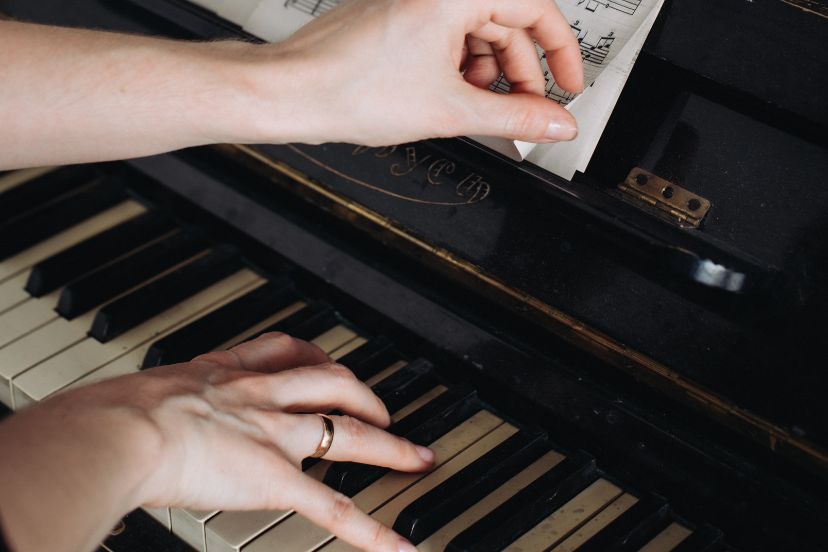For those looking to learn piano in a creative and enjoyable way, Creative Piano Academy offers…
Main Piano Chords and Concepts: A Guide for Beginners

There’s a magic to the piano, an instrument that has captivated the world with its range of sounds and the melodies it can create. Whether it’s a pop song or a classic tune, the piano is at the heart of many music genres.
This article will serve as an introduction to the basic piano chords, how to read music, and how to play more songs.
The Keyboard: White and Black Keys
The first thing a person encounters is the keyboard. It features white keys and black keys. The white keys represent the major notes (A, B, C, D, E, F, G), while the black keys represent the sharp or minor notes.
For beginners, understanding these keys is crucial, as they form the basis of all chords and melodies you will play.
Understanding Basic Piano Chords
Chords are combinations of individual notes played together to create a harmony. They are the building blocks of most songs and are typically played with the left hand on the piano.
The most basic piano chords are the major and minor chords. A major chord is formed from the root note, a major third, and a perfect fifth. For example, the C major chord includes the notes C, E, and G.
On the other hand, a minor chord is formed from the root note, a minor third, and a perfect fifth. So, a C minor chord would include the notes C, E flat, and G.
Reading Sheet Music
Being able to read music is a critical skill in your piano journey. Sheet music contains all the information you need to play a song – the melody, chords, and rhythm. It might look like a complex system of symbols and lines at the beginning, but with practice, you’ll be reading sheet music as easily as you read this article.
Playing Your First Song
Once you’ve grasped the basic piano chords and have begun to read music, it’s time to play your first song. Pop songs are a great starting point as they frequently have simple chord progressions and catchy melodies.
Start by listening to the song you’ve decided to play. Pay attention to the melody and rhythm. Then, look up the sheet music for the song. Begin by playing the melody with your right hand. Once you’re comfortable with that, add in the left-hand chords.
Improvisation and Creation
Once you’ve got the hang of playing pre-written songs, you might want to try your hand at improvisation. This is where you create your own melodies and harmonies, either as a solo performance or as a cover of an existing song.
Improvisation is a fun way to express your creativity and make a piece uniquely yours. It can also be a great method of practice, helping to reinforce your knowledge of chords and scales.
Piano Adventures and Further Learning
As you become more comfortable with your piano, you might want to explore other keys and additional notes.
You may want to learn more complex chords, like sevenths or diminished chords. There are many free resources available online, including video tutorials, digital courses, and printable scores.
Your learning path also lead you to different genres of music. Perhaps you’ll fall in love with the rich sounds of jazz piano, or the driving rhythms of rock. Maybe you’ll enjoy the challenge of classical pieces, or the freedom of improvisation.

Piano FAQs
The piano is a beautiful instrument that has been around for centuries. It has been used to create some of the most iconic tunes in the world of music. This guide is aimed at beginners who want to learn more about playing, including chords, notes, and songs.
What are some popular songs that can be played on the piano?
There are countless pop songs, rock tunes, and classical pieces that can be played on the piano. Some popular songs to try include “Let It Be” by The Beatles, “Someone Like You” by Adele, and “Fur Elise” by Beethoven.
How do I play piano chords?
Piano chords involve playing multiple notes simultaneously. To play a chord, place your fingers on the appropriate keys and play them together. There are numerous video tutorials available online that can help you learn the basics of piano chords.
Can I play with just one hand?
While most songs are played with both hands, there are some simpler pieces that can be played with just one hand. If you are a beginner, it might be easier to start with one hand and gradually work your way up to the art of using both.
How do I practice playing the piano?
Practice is key when it comes to playing the piano. Set aside some time each day to perform your chords and notes. Work on playing different songs and experiment with different techniques.
What are some tips for beginners?
If you are just starting out, it’s important to take things slow. Focus on mastering the basics before moving on to more difficult pieces. Some students focus on just one key as they are introduced concepts.
It’s also a good idea to learn some music theory so that you have a better understanding of how songs are structured.
What is the difference between major and minor chords?
Major chords tend to sound bright and cheerful, while minor chords sound more melancholy. Both types of chords are used extensively in music.
What is the best method for learning piano?
There are many different methods available for learning the piano. Some people prefer to take formal lessons from a teacher, while others prefer to use online resources. Ultimately, the best method is the one that works best for you.
That being said, this is our recommended best way to learn piano.
Can I learn piano without a physical keyboard?
With the rise of digital technology, it is now possible to learn piano without a physical keyboard. There are numerous apps and software programs created that allow you to practice playing the piano on your smartphone or computer.
How do I review my progress as a piano student?
It’s important to regularly assess your progress as a piano student. You can do this by recording yourself playing a piece and listening back to it. You can also ask friends or other pianists for feedback.
Are there any free resources for learning piano?
There are many free resources available online for learning piano. Some popular options include YouTube videos, online course options, and music theory websites.
Summary of Main Piano Concepts
In conclusion, learning to play the piano is a rewarding journey. It requires patience, practice, and a love of music, but the joy of creating beautiful sounds and sharing them with friends and family is well worth it.
Whether you’re a student looking for a new hobby, a parent teaching their child, or an adult returning to an instrument they once played, the piano offers endless opportunities for fun, creativity, and personal expression.



